Nursing Essay: Evaluating Evidence on Stimulant Use in Universities
VerifiedAdded on 2020/05/11
|11
|2617
|362
Essay
AI Summary
This nursing essay critically evaluates two research papers addressing the use of stimulants by university students to enhance academic performance. The essay begins by introducing a clinical question developed using the PICO framework, exploring whether stimulants increase academic success. It then analyzes a qualitative study examining the life context of stimulant use and a quantitative study assessing the relationship between non-medical stimulant use, executive functioning, and academic outcomes. The essay highlights the strengths and weaknesses of each study, considering authorship, research aims, design, and findings. Furthermore, it discusses the barriers to implementing the evidence, such as subjective data from qualitative studies and potential biases in quantitative research. The essay concludes that while stimulants may improve academic performance, particularly for those with executive function deficits, non-medical use carries risks. The essay recommends that students consult physicians before using stimulants and emphasizes the need for further research to compare medical and non-medical stimulant use.
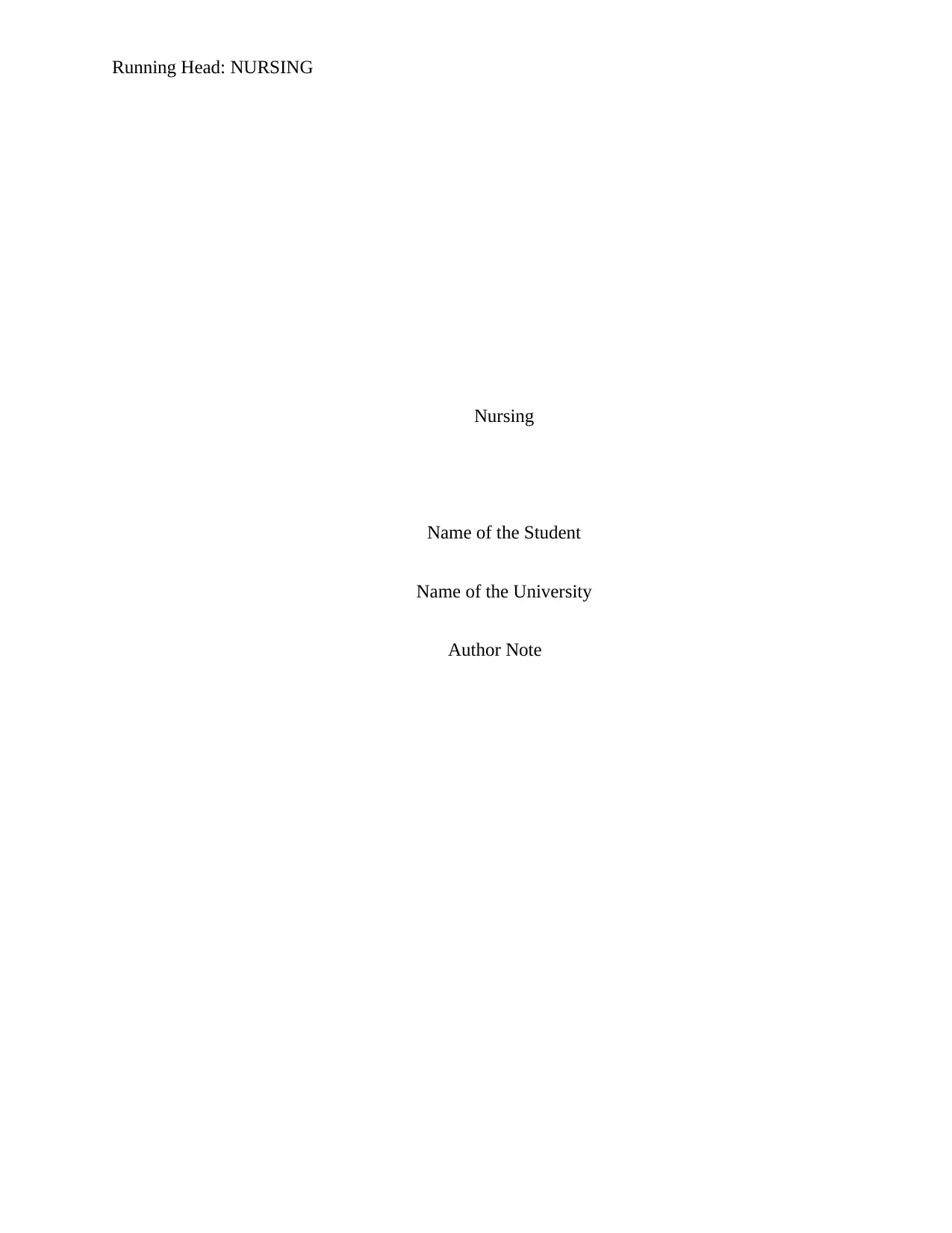
Running Head: NURSING
Nursing
Name of the Student
Name of the University
Author Note
Nursing
Name of the Student
Name of the University
Author Note
Paraphrase This Document
Need a fresh take? Get an instant paraphrase of this document with our AI Paraphraser
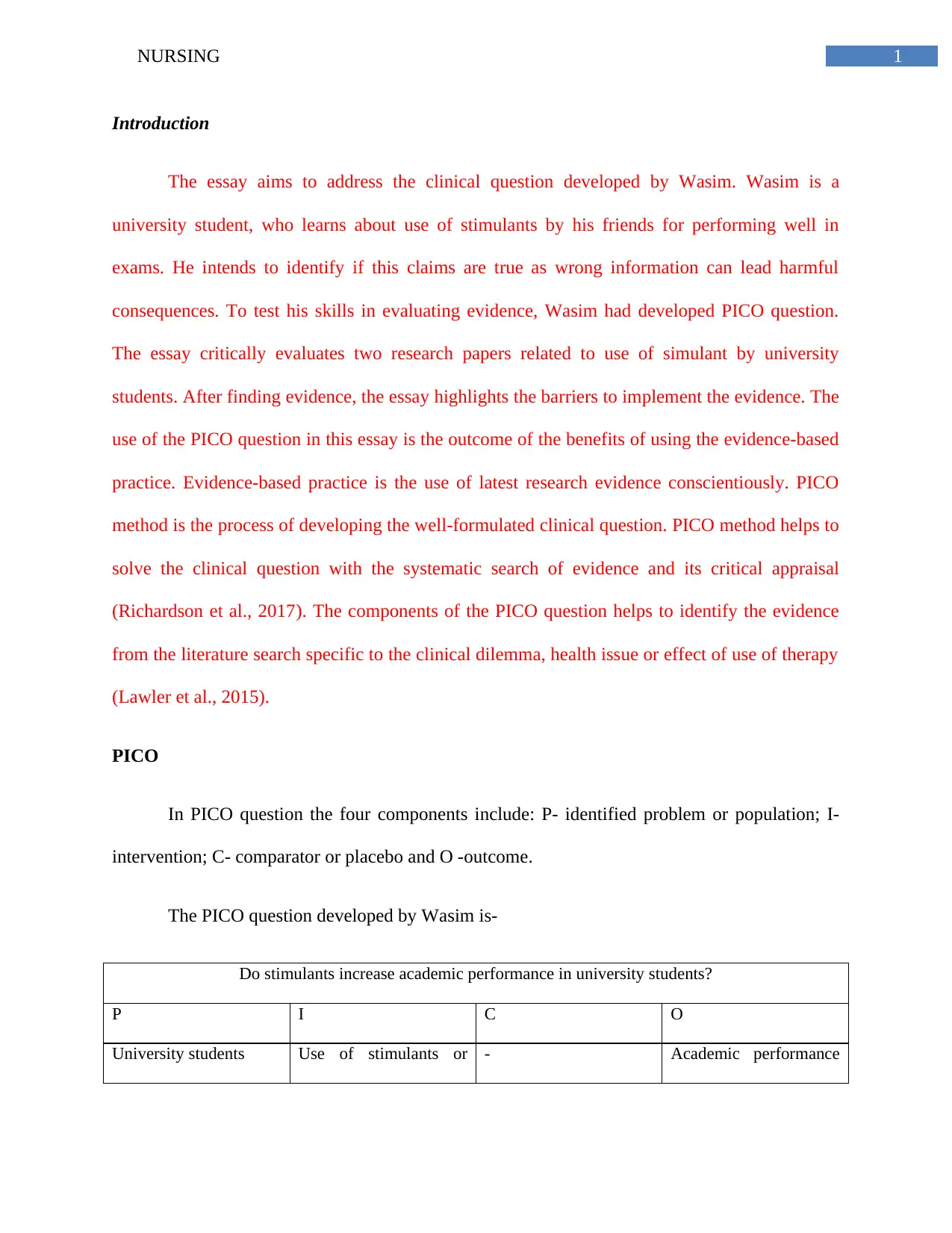
1NURSING
Introduction
The essay aims to address the clinical question developed by Wasim. Wasim is a
university student, who learns about use of stimulants by his friends for performing well in
exams. He intends to identify if this claims are true as wrong information can lead harmful
consequences. To test his skills in evaluating evidence, Wasim had developed PICO question.
The essay critically evaluates two research papers related to use of simulant by university
students. After finding evidence, the essay highlights the barriers to implement the evidence. The
use of the PICO question in this essay is the outcome of the benefits of using the evidence-based
practice. Evidence-based practice is the use of latest research evidence conscientiously. PICO
method is the process of developing the well-formulated clinical question. PICO method helps to
solve the clinical question with the systematic search of evidence and its critical appraisal
(Richardson et al., 2017). The components of the PICO question helps to identify the evidence
from the literature search specific to the clinical dilemma, health issue or effect of use of therapy
(Lawler et al., 2015).
PICO
In PICO question the four components include: P- identified problem or population; I-
intervention; C- comparator or placebo and O -outcome.
The PICO question developed by Wasim is-
Do stimulants increase academic performance in university students?
P I C O
University students Use of stimulants or - Academic performance
Introduction
The essay aims to address the clinical question developed by Wasim. Wasim is a
university student, who learns about use of stimulants by his friends for performing well in
exams. He intends to identify if this claims are true as wrong information can lead harmful
consequences. To test his skills in evaluating evidence, Wasim had developed PICO question.
The essay critically evaluates two research papers related to use of simulant by university
students. After finding evidence, the essay highlights the barriers to implement the evidence. The
use of the PICO question in this essay is the outcome of the benefits of using the evidence-based
practice. Evidence-based practice is the use of latest research evidence conscientiously. PICO
method is the process of developing the well-formulated clinical question. PICO method helps to
solve the clinical question with the systematic search of evidence and its critical appraisal
(Richardson et al., 2017). The components of the PICO question helps to identify the evidence
from the literature search specific to the clinical dilemma, health issue or effect of use of therapy
(Lawler et al., 2015).
PICO
In PICO question the four components include: P- identified problem or population; I-
intervention; C- comparator or placebo and O -outcome.
The PICO question developed by Wasim is-
Do stimulants increase academic performance in university students?
P I C O
University students Use of stimulants or - Academic performance
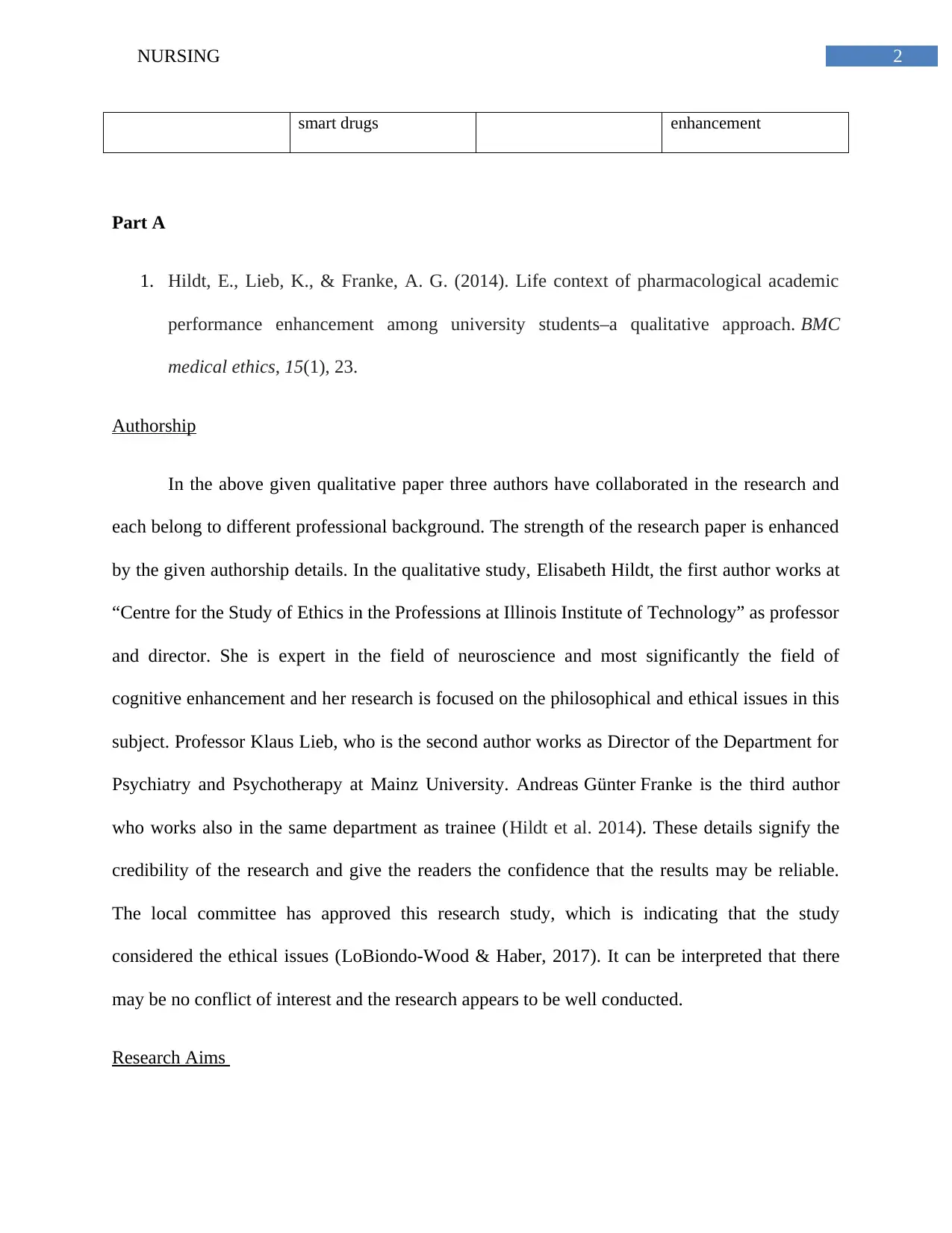
2NURSING
smart drugs enhancement
Part A
1. Hildt, E., Lieb, K., & Franke, A. G. (2014). Life context of pharmacological academic
performance enhancement among university students–a qualitative approach. BMC
medical ethics, 15(1), 23.
Authorship
In the above given qualitative paper three authors have collaborated in the research and
each belong to different professional background. The strength of the research paper is enhanced
by the given authorship details. In the qualitative study, Elisabeth Hildt, the first author works at
“Centre for the Study of Ethics in the Professions at Illinois Institute of Technology” as professor
and director. She is expert in the field of neuroscience and most significantly the field of
cognitive enhancement and her research is focused on the philosophical and ethical issues in this
subject. Professor Klaus Lieb, who is the second author works as Director of the Department for
Psychiatry and Psychotherapy at Mainz University. Andreas Günter Franke is the third author
who works also in the same department as trainee (Hildt et al. 2014). These details signify the
credibility of the research and give the readers the confidence that the results may be reliable.
The local committee has approved this research study, which is indicating that the study
considered the ethical issues (LoBiondo-Wood & Haber, 2017). It can be interpreted that there
may be no conflict of interest and the research appears to be well conducted.
Research Aims
smart drugs enhancement
Part A
1. Hildt, E., Lieb, K., & Franke, A. G. (2014). Life context of pharmacological academic
performance enhancement among university students–a qualitative approach. BMC
medical ethics, 15(1), 23.
Authorship
In the above given qualitative paper three authors have collaborated in the research and
each belong to different professional background. The strength of the research paper is enhanced
by the given authorship details. In the qualitative study, Elisabeth Hildt, the first author works at
“Centre for the Study of Ethics in the Professions at Illinois Institute of Technology” as professor
and director. She is expert in the field of neuroscience and most significantly the field of
cognitive enhancement and her research is focused on the philosophical and ethical issues in this
subject. Professor Klaus Lieb, who is the second author works as Director of the Department for
Psychiatry and Psychotherapy at Mainz University. Andreas Günter Franke is the third author
who works also in the same department as trainee (Hildt et al. 2014). These details signify the
credibility of the research and give the readers the confidence that the results may be reliable.
The local committee has approved this research study, which is indicating that the study
considered the ethical issues (LoBiondo-Wood & Haber, 2017). It can be interpreted that there
may be no conflict of interest and the research appears to be well conducted.
Research Aims
⊘ This is a preview!⊘
Do you want full access?
Subscribe today to unlock all pages.

Trusted by 1+ million students worldwide
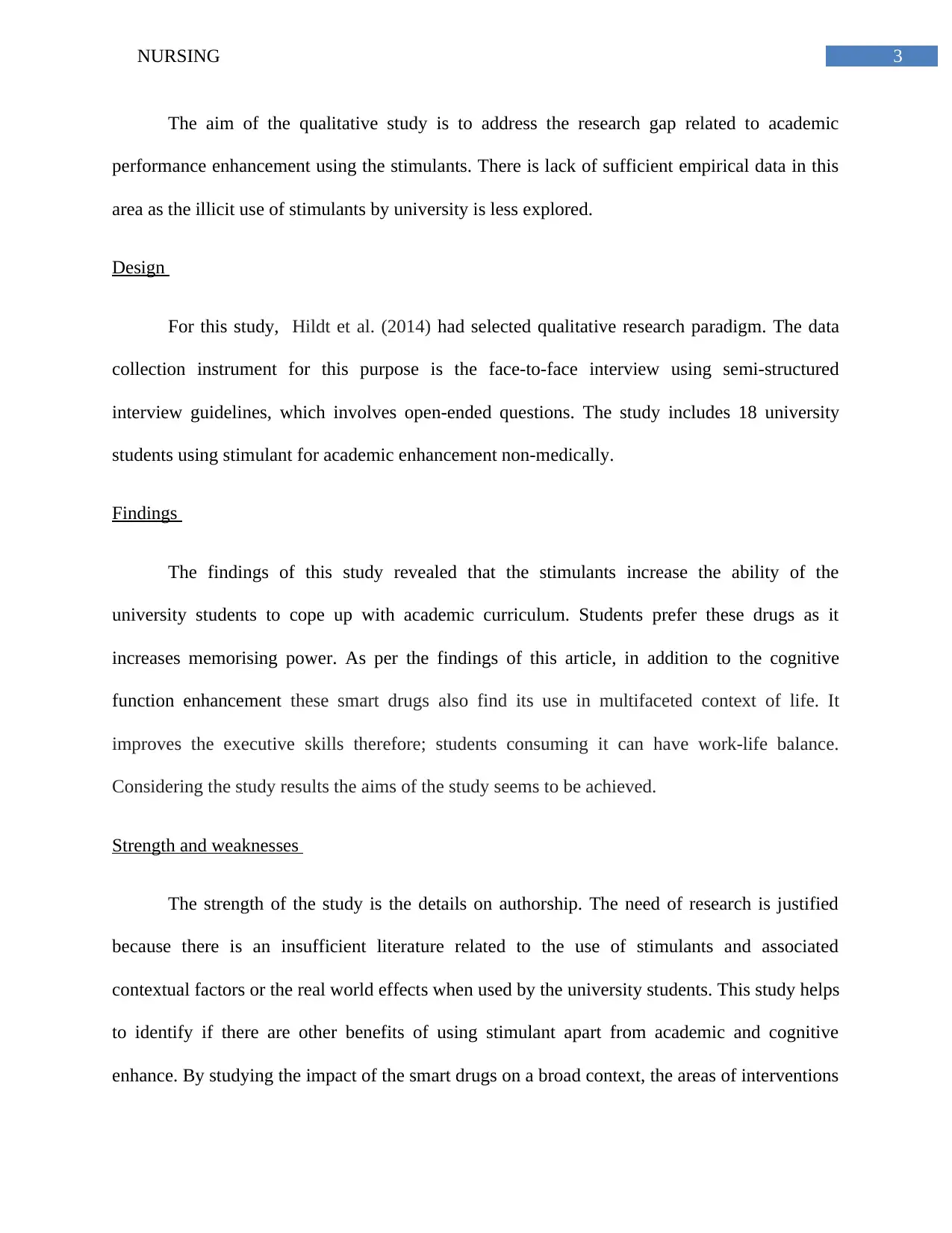
3NURSING
The aim of the qualitative study is to address the research gap related to academic
performance enhancement using the stimulants. There is lack of sufficient empirical data in this
area as the illicit use of stimulants by university is less explored.
Design
For this study, Hildt et al. (2014) had selected qualitative research paradigm. The data
collection instrument for this purpose is the face-to-face interview using semi-structured
interview guidelines, which involves open-ended questions. The study includes 18 university
students using stimulant for academic enhancement non-medically.
Findings
The findings of this study revealed that the stimulants increase the ability of the
university students to cope up with academic curriculum. Students prefer these drugs as it
increases memorising power. As per the findings of this article, in addition to the cognitive
function enhancement these smart drugs also find its use in multifaceted context of life. It
improves the executive skills therefore; students consuming it can have work-life balance.
Considering the study results the aims of the study seems to be achieved.
Strength and weaknesses
The strength of the study is the details on authorship. The need of research is justified
because there is an insufficient literature related to the use of stimulants and associated
contextual factors or the real world effects when used by the university students. This study helps
to identify if there are other benefits of using stimulant apart from academic and cognitive
enhance. By studying the impact of the smart drugs on a broad context, the areas of interventions
The aim of the qualitative study is to address the research gap related to academic
performance enhancement using the stimulants. There is lack of sufficient empirical data in this
area as the illicit use of stimulants by university is less explored.
Design
For this study, Hildt et al. (2014) had selected qualitative research paradigm. The data
collection instrument for this purpose is the face-to-face interview using semi-structured
interview guidelines, which involves open-ended questions. The study includes 18 university
students using stimulant for academic enhancement non-medically.
Findings
The findings of this study revealed that the stimulants increase the ability of the
university students to cope up with academic curriculum. Students prefer these drugs as it
increases memorising power. As per the findings of this article, in addition to the cognitive
function enhancement these smart drugs also find its use in multifaceted context of life. It
improves the executive skills therefore; students consuming it can have work-life balance.
Considering the study results the aims of the study seems to be achieved.
Strength and weaknesses
The strength of the study is the details on authorship. The need of research is justified
because there is an insufficient literature related to the use of stimulants and associated
contextual factors or the real world effects when used by the university students. This study helps
to identify if there are other benefits of using stimulant apart from academic and cognitive
enhance. By studying the impact of the smart drugs on a broad context, the areas of interventions
Paraphrase This Document
Need a fresh take? Get an instant paraphrase of this document with our AI Paraphraser
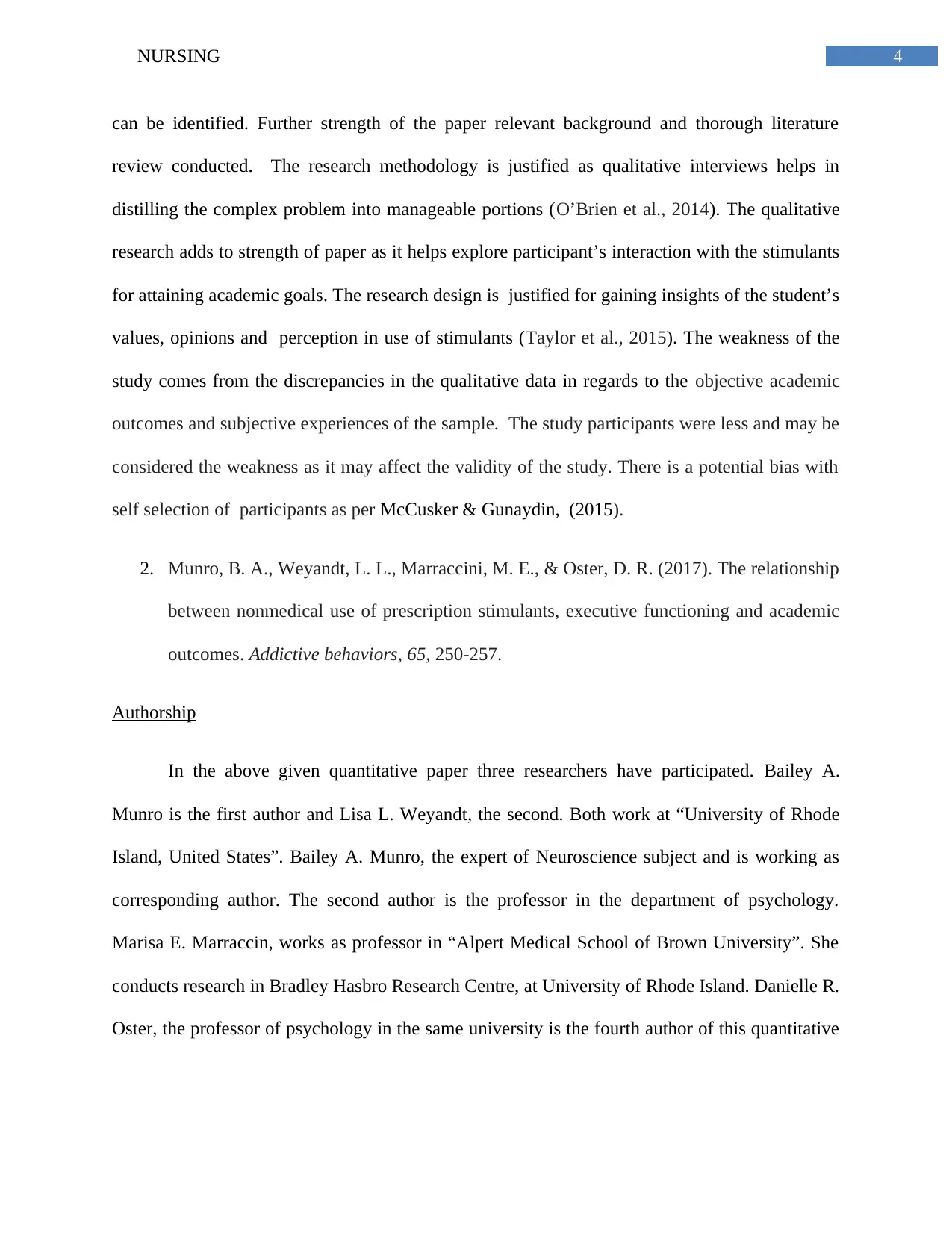
4NURSING
can be identified. Further strength of the paper relevant background and thorough literature
review conducted. The research methodology is justified as qualitative interviews helps in
distilling the complex problem into manageable portions (O’Brien et al., 2014). The qualitative
research adds to strength of paper as it helps explore participant’s interaction with the stimulants
for attaining academic goals. The research design is justified for gaining insights of the student’s
values, opinions and perception in use of stimulants (Taylor et al., 2015). The weakness of the
study comes from the discrepancies in the qualitative data in regards to the objective academic
outcomes and subjective experiences of the sample. The study participants were less and may be
considered the weakness as it may affect the validity of the study. There is a potential bias with
self selection of participants as per McCusker & Gunaydin, (2015).
2. Munro, B. A., Weyandt, L. L., Marraccini, M. E., & Oster, D. R. (2017). The relationship
between nonmedical use of prescription stimulants, executive functioning and academic
outcomes. Addictive behaviors, 65, 250-257.
Authorship
In the above given quantitative paper three researchers have participated. Bailey A.
Munro is the first author and Lisa L. Weyandt, the second. Both work at “University of Rhode
Island, United States”. Bailey A. Munro, the expert of Neuroscience subject and is working as
corresponding author. The second author is the professor in the department of psychology.
Marisa E. Marraccin, works as professor in “Alpert Medical School of Brown University”. She
conducts research in Bradley Hasbro Research Centre, at University of Rhode Island. Danielle R.
Oster, the professor of psychology in the same university is the fourth author of this quantitative
can be identified. Further strength of the paper relevant background and thorough literature
review conducted. The research methodology is justified as qualitative interviews helps in
distilling the complex problem into manageable portions (O’Brien et al., 2014). The qualitative
research adds to strength of paper as it helps explore participant’s interaction with the stimulants
for attaining academic goals. The research design is justified for gaining insights of the student’s
values, opinions and perception in use of stimulants (Taylor et al., 2015). The weakness of the
study comes from the discrepancies in the qualitative data in regards to the objective academic
outcomes and subjective experiences of the sample. The study participants were less and may be
considered the weakness as it may affect the validity of the study. There is a potential bias with
self selection of participants as per McCusker & Gunaydin, (2015).
2. Munro, B. A., Weyandt, L. L., Marraccini, M. E., & Oster, D. R. (2017). The relationship
between nonmedical use of prescription stimulants, executive functioning and academic
outcomes. Addictive behaviors, 65, 250-257.
Authorship
In the above given quantitative paper three researchers have participated. Bailey A.
Munro is the first author and Lisa L. Weyandt, the second. Both work at “University of Rhode
Island, United States”. Bailey A. Munro, the expert of Neuroscience subject and is working as
corresponding author. The second author is the professor in the department of psychology.
Marisa E. Marraccin, works as professor in “Alpert Medical School of Brown University”. She
conducts research in Bradley Hasbro Research Centre, at University of Rhode Island. Danielle R.
Oster, the professor of psychology in the same university is the fourth author of this quantitative
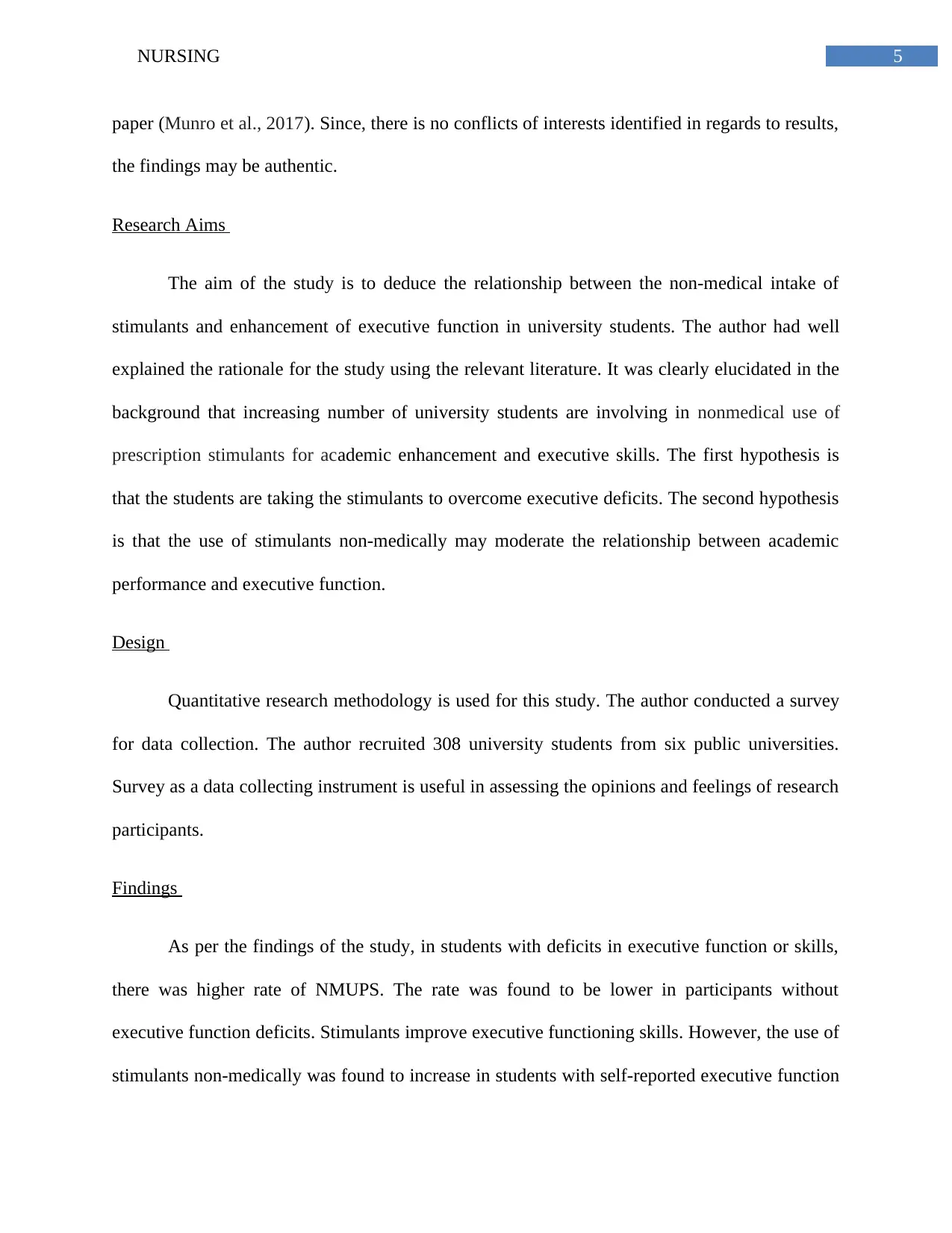
5NURSING
paper (Munro et al., 2017). Since, there is no conflicts of interests identified in regards to results,
the findings may be authentic.
Research Aims
The aim of the study is to deduce the relationship between the non-medical intake of
stimulants and enhancement of executive function in university students. The author had well
explained the rationale for the study using the relevant literature. It was clearly elucidated in the
background that increasing number of university students are involving in nonmedical use of
prescription stimulants for academic enhancement and executive skills. The first hypothesis is
that the students are taking the stimulants to overcome executive deficits. The second hypothesis
is that the use of stimulants non-medically may moderate the relationship between academic
performance and executive function.
Design
Quantitative research methodology is used for this study. The author conducted a survey
for data collection. The author recruited 308 university students from six public universities.
Survey as a data collecting instrument is useful in assessing the opinions and feelings of research
participants.
Findings
As per the findings of the study, in students with deficits in executive function or skills,
there was higher rate of NMUPS. The rate was found to be lower in participants without
executive function deficits. Stimulants improve executive functioning skills. However, the use of
stimulants non-medically was found to increase in students with self-reported executive function
paper (Munro et al., 2017). Since, there is no conflicts of interests identified in regards to results,
the findings may be authentic.
Research Aims
The aim of the study is to deduce the relationship between the non-medical intake of
stimulants and enhancement of executive function in university students. The author had well
explained the rationale for the study using the relevant literature. It was clearly elucidated in the
background that increasing number of university students are involving in nonmedical use of
prescription stimulants for academic enhancement and executive skills. The first hypothesis is
that the students are taking the stimulants to overcome executive deficits. The second hypothesis
is that the use of stimulants non-medically may moderate the relationship between academic
performance and executive function.
Design
Quantitative research methodology is used for this study. The author conducted a survey
for data collection. The author recruited 308 university students from six public universities.
Survey as a data collecting instrument is useful in assessing the opinions and feelings of research
participants.
Findings
As per the findings of the study, in students with deficits in executive function or skills,
there was higher rate of NMUPS. The rate was found to be lower in participants without
executive function deficits. Stimulants improve executive functioning skills. However, the use of
stimulants non-medically was found to increase in students with self-reported executive function
⊘ This is a preview!⊘
Do you want full access?
Subscribe today to unlock all pages.

Trusted by 1+ million students worldwide
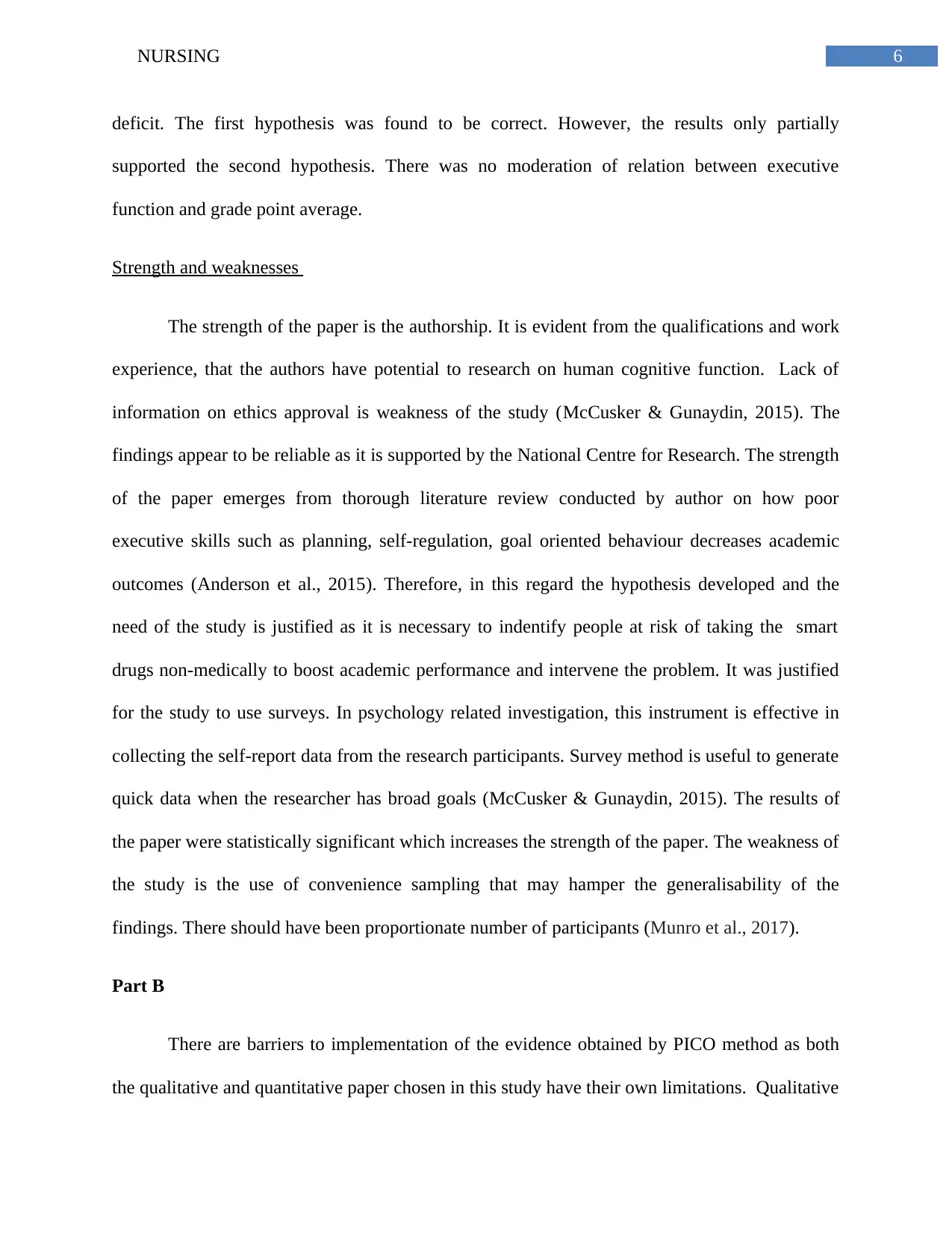
6NURSING
deficit. The first hypothesis was found to be correct. However, the results only partially
supported the second hypothesis. There was no moderation of relation between executive
function and grade point average.
Strength and weaknesses
The strength of the paper is the authorship. It is evident from the qualifications and work
experience, that the authors have potential to research on human cognitive function. Lack of
information on ethics approval is weakness of the study (McCusker & Gunaydin, 2015). The
findings appear to be reliable as it is supported by the National Centre for Research. The strength
of the paper emerges from thorough literature review conducted by author on how poor
executive skills such as planning, self-regulation, goal oriented behaviour decreases academic
outcomes (Anderson et al., 2015). Therefore, in this regard the hypothesis developed and the
need of the study is justified as it is necessary to indentify people at risk of taking the smart
drugs non-medically to boost academic performance and intervene the problem. It was justified
for the study to use surveys. In psychology related investigation, this instrument is effective in
collecting the self-report data from the research participants. Survey method is useful to generate
quick data when the researcher has broad goals (McCusker & Gunaydin, 2015). The results of
the paper were statistically significant which increases the strength of the paper. The weakness of
the study is the use of convenience sampling that may hamper the generalisability of the
findings. There should have been proportionate number of participants (Munro et al., 2017).
Part B
There are barriers to implementation of the evidence obtained by PICO method as both
the qualitative and quantitative paper chosen in this study have their own limitations. Qualitative
deficit. The first hypothesis was found to be correct. However, the results only partially
supported the second hypothesis. There was no moderation of relation between executive
function and grade point average.
Strength and weaknesses
The strength of the paper is the authorship. It is evident from the qualifications and work
experience, that the authors have potential to research on human cognitive function. Lack of
information on ethics approval is weakness of the study (McCusker & Gunaydin, 2015). The
findings appear to be reliable as it is supported by the National Centre for Research. The strength
of the paper emerges from thorough literature review conducted by author on how poor
executive skills such as planning, self-regulation, goal oriented behaviour decreases academic
outcomes (Anderson et al., 2015). Therefore, in this regard the hypothesis developed and the
need of the study is justified as it is necessary to indentify people at risk of taking the smart
drugs non-medically to boost academic performance and intervene the problem. It was justified
for the study to use surveys. In psychology related investigation, this instrument is effective in
collecting the self-report data from the research participants. Survey method is useful to generate
quick data when the researcher has broad goals (McCusker & Gunaydin, 2015). The results of
the paper were statistically significant which increases the strength of the paper. The weakness of
the study is the use of convenience sampling that may hamper the generalisability of the
findings. There should have been proportionate number of participants (Munro et al., 2017).
Part B
There are barriers to implementation of the evidence obtained by PICO method as both
the qualitative and quantitative paper chosen in this study have their own limitations. Qualitative
Paraphrase This Document
Need a fresh take? Get an instant paraphrase of this document with our AI Paraphraser
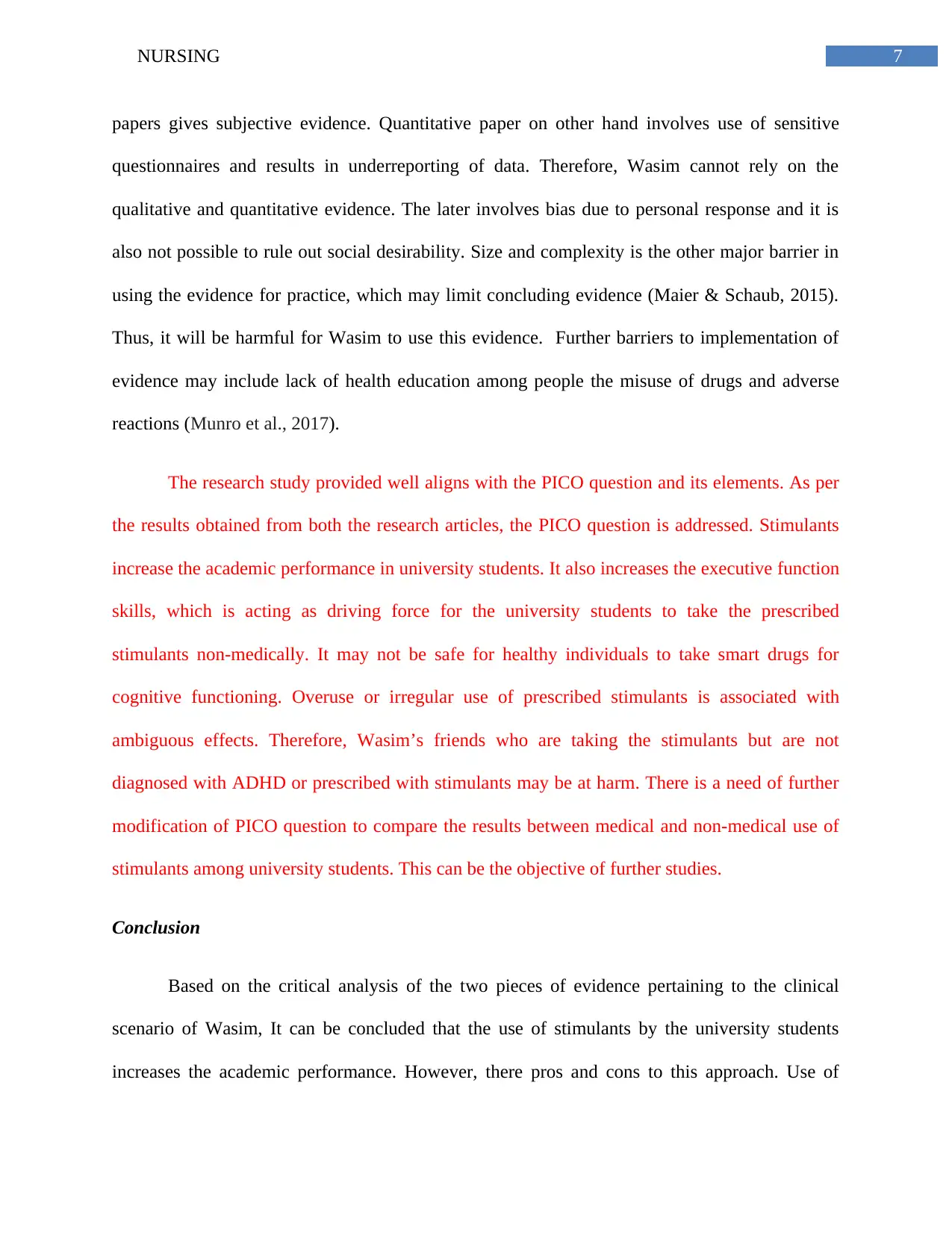
7NURSING
papers gives subjective evidence. Quantitative paper on other hand involves use of sensitive
questionnaires and results in underreporting of data. Therefore, Wasim cannot rely on the
qualitative and quantitative evidence. The later involves bias due to personal response and it is
also not possible to rule out social desirability. Size and complexity is the other major barrier in
using the evidence for practice, which may limit concluding evidence (Maier & Schaub, 2015).
Thus, it will be harmful for Wasim to use this evidence. Further barriers to implementation of
evidence may include lack of health education among people the misuse of drugs and adverse
reactions (Munro et al., 2017).
The research study provided well aligns with the PICO question and its elements. As per
the results obtained from both the research articles, the PICO question is addressed. Stimulants
increase the academic performance in university students. It also increases the executive function
skills, which is acting as driving force for the university students to take the prescribed
stimulants non-medically. It may not be safe for healthy individuals to take smart drugs for
cognitive functioning. Overuse or irregular use of prescribed stimulants is associated with
ambiguous effects. Therefore, Wasim’s friends who are taking the stimulants but are not
diagnosed with ADHD or prescribed with stimulants may be at harm. There is a need of further
modification of PICO question to compare the results between medical and non-medical use of
stimulants among university students. This can be the objective of further studies.
Conclusion
Based on the critical analysis of the two pieces of evidence pertaining to the clinical
scenario of Wasim, It can be concluded that the use of stimulants by the university students
increases the academic performance. However, there pros and cons to this approach. Use of
papers gives subjective evidence. Quantitative paper on other hand involves use of sensitive
questionnaires and results in underreporting of data. Therefore, Wasim cannot rely on the
qualitative and quantitative evidence. The later involves bias due to personal response and it is
also not possible to rule out social desirability. Size and complexity is the other major barrier in
using the evidence for practice, which may limit concluding evidence (Maier & Schaub, 2015).
Thus, it will be harmful for Wasim to use this evidence. Further barriers to implementation of
evidence may include lack of health education among people the misuse of drugs and adverse
reactions (Munro et al., 2017).
The research study provided well aligns with the PICO question and its elements. As per
the results obtained from both the research articles, the PICO question is addressed. Stimulants
increase the academic performance in university students. It also increases the executive function
skills, which is acting as driving force for the university students to take the prescribed
stimulants non-medically. It may not be safe for healthy individuals to take smart drugs for
cognitive functioning. Overuse or irregular use of prescribed stimulants is associated with
ambiguous effects. Therefore, Wasim’s friends who are taking the stimulants but are not
diagnosed with ADHD or prescribed with stimulants may be at harm. There is a need of further
modification of PICO question to compare the results between medical and non-medical use of
stimulants among university students. This can be the objective of further studies.
Conclusion
Based on the critical analysis of the two pieces of evidence pertaining to the clinical
scenario of Wasim, It can be concluded that the use of stimulants by the university students
increases the academic performance. However, there pros and cons to this approach. Use of
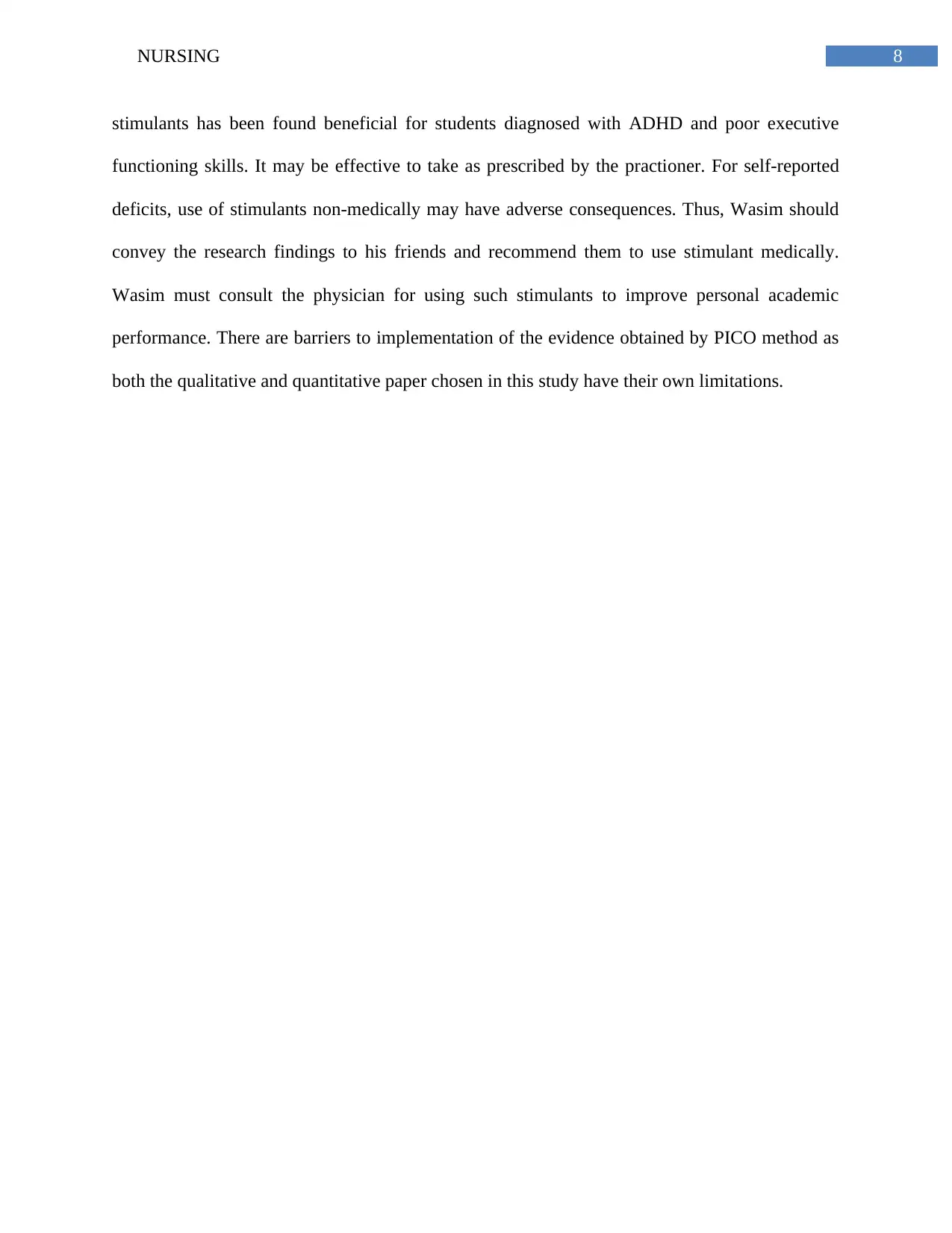
8NURSING
stimulants has been found beneficial for students diagnosed with ADHD and poor executive
functioning skills. It may be effective to take as prescribed by the practioner. For self-reported
deficits, use of stimulants non-medically may have adverse consequences. Thus, Wasim should
convey the research findings to his friends and recommend them to use stimulant medically.
Wasim must consult the physician for using such stimulants to improve personal academic
performance. There are barriers to implementation of the evidence obtained by PICO method as
both the qualitative and quantitative paper chosen in this study have their own limitations.
stimulants has been found beneficial for students diagnosed with ADHD and poor executive
functioning skills. It may be effective to take as prescribed by the practioner. For self-reported
deficits, use of stimulants non-medically may have adverse consequences. Thus, Wasim should
convey the research findings to his friends and recommend them to use stimulant medically.
Wasim must consult the physician for using such stimulants to improve personal academic
performance. There are barriers to implementation of the evidence obtained by PICO method as
both the qualitative and quantitative paper chosen in this study have their own limitations.
⊘ This is a preview!⊘
Do you want full access?
Subscribe today to unlock all pages.

Trusted by 1+ million students worldwide
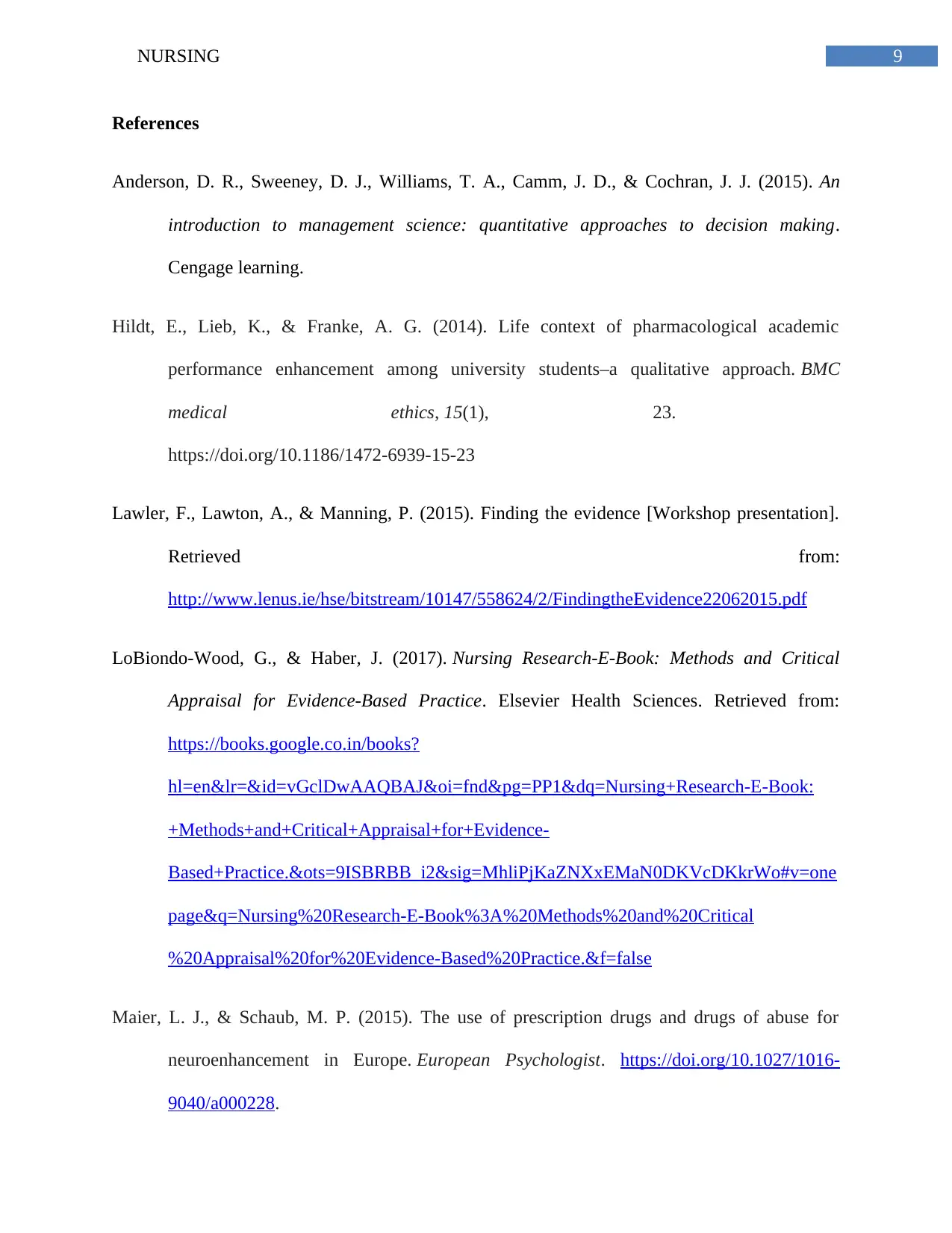
9NURSING
References
Anderson, D. R., Sweeney, D. J., Williams, T. A., Camm, J. D., & Cochran, J. J. (2015). An
introduction to management science: quantitative approaches to decision making.
Cengage learning.
Hildt, E., Lieb, K., & Franke, A. G. (2014). Life context of pharmacological academic
performance enhancement among university students–a qualitative approach. BMC
medical ethics, 15(1), 23.
https://doi.org/10.1186/1472-6939-15-23
Lawler, F., Lawton, A., & Manning, P. (2015). Finding the evidence [Workshop presentation].
Retrieved from:
http://www.lenus.ie/hse/bitstream/10147/558624/2/FindingtheEvidence22062015.pdf
LoBiondo-Wood, G., & Haber, J. (2017). Nursing Research-E-Book: Methods and Critical
Appraisal for Evidence-Based Practice. Elsevier Health Sciences. Retrieved from:
https://books.google.co.in/books?
hl=en&lr=&id=vGclDwAAQBAJ&oi=fnd&pg=PP1&dq=Nursing+Research-E-Book:
+Methods+and+Critical+Appraisal+for+Evidence-
Based+Practice.&ots=9ISBRBB_i2&sig=MhliPjKaZNXxEMaN0DKVcDKkrWo#v=one
page&q=Nursing%20Research-E-Book%3A%20Methods%20and%20Critical
%20Appraisal%20for%20Evidence-Based%20Practice.&f=false
Maier, L. J., & Schaub, M. P. (2015). The use of prescription drugs and drugs of abuse for
neuroenhancement in Europe. European Psychologist. https://doi.org/10.1027/1016-
9040/a000228.
References
Anderson, D. R., Sweeney, D. J., Williams, T. A., Camm, J. D., & Cochran, J. J. (2015). An
introduction to management science: quantitative approaches to decision making.
Cengage learning.
Hildt, E., Lieb, K., & Franke, A. G. (2014). Life context of pharmacological academic
performance enhancement among university students–a qualitative approach. BMC
medical ethics, 15(1), 23.
https://doi.org/10.1186/1472-6939-15-23
Lawler, F., Lawton, A., & Manning, P. (2015). Finding the evidence [Workshop presentation].
Retrieved from:
http://www.lenus.ie/hse/bitstream/10147/558624/2/FindingtheEvidence22062015.pdf
LoBiondo-Wood, G., & Haber, J. (2017). Nursing Research-E-Book: Methods and Critical
Appraisal for Evidence-Based Practice. Elsevier Health Sciences. Retrieved from:
https://books.google.co.in/books?
hl=en&lr=&id=vGclDwAAQBAJ&oi=fnd&pg=PP1&dq=Nursing+Research-E-Book:
+Methods+and+Critical+Appraisal+for+Evidence-
Based+Practice.&ots=9ISBRBB_i2&sig=MhliPjKaZNXxEMaN0DKVcDKkrWo#v=one
page&q=Nursing%20Research-E-Book%3A%20Methods%20and%20Critical
%20Appraisal%20for%20Evidence-Based%20Practice.&f=false
Maier, L. J., & Schaub, M. P. (2015). The use of prescription drugs and drugs of abuse for
neuroenhancement in Europe. European Psychologist. https://doi.org/10.1027/1016-
9040/a000228.
Paraphrase This Document
Need a fresh take? Get an instant paraphrase of this document with our AI Paraphraser
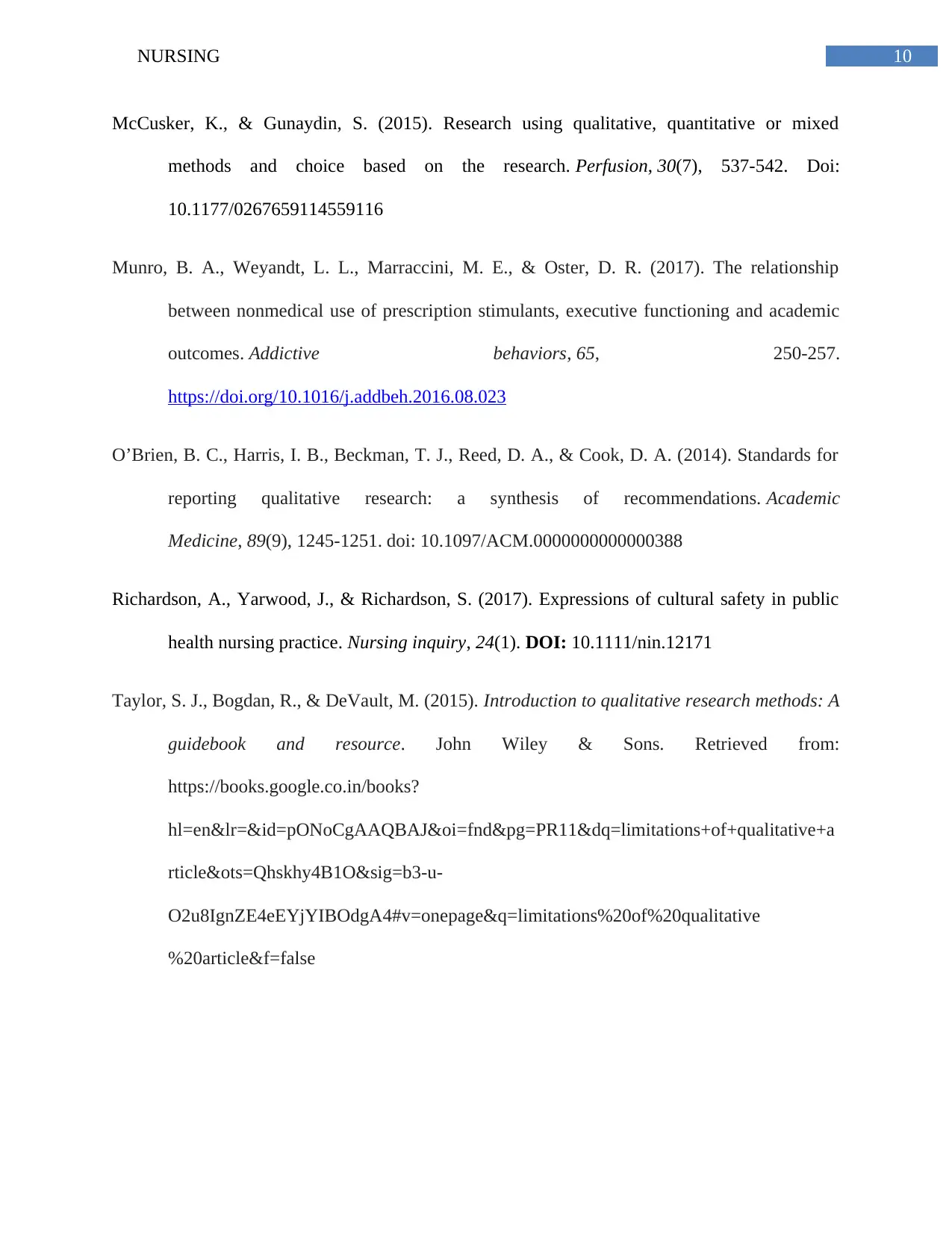
10NURSING
McCusker, K., & Gunaydin, S. (2015). Research using qualitative, quantitative or mixed
methods and choice based on the research. Perfusion, 30(7), 537-542. Doi:
10.1177/0267659114559116
Munro, B. A., Weyandt, L. L., Marraccini, M. E., & Oster, D. R. (2017). The relationship
between nonmedical use of prescription stimulants, executive functioning and academic
outcomes. Addictive behaviors, 65, 250-257.
https://doi.org/10.1016/j.addbeh.2016.08.023
O’Brien, B. C., Harris, I. B., Beckman, T. J., Reed, D. A., & Cook, D. A. (2014). Standards for
reporting qualitative research: a synthesis of recommendations. Academic
Medicine, 89(9), 1245-1251. doi: 10.1097/ACM.0000000000000388
Richardson, A., Yarwood, J., & Richardson, S. (2017). Expressions of cultural safety in public
health nursing practice. Nursing inquiry, 24(1). DOI: 10.1111/nin.12171
Taylor, S. J., Bogdan, R., & DeVault, M. (2015). Introduction to qualitative research methods: A
guidebook and resource. John Wiley & Sons. Retrieved from:
https://books.google.co.in/books?
hl=en&lr=&id=pONoCgAAQBAJ&oi=fnd&pg=PR11&dq=limitations+of+qualitative+a
rticle&ots=Qhskhy4B1O&sig=b3-u-
O2u8IgnZE4eEYjYIBOdgA4#v=onepage&q=limitations%20of%20qualitative
%20article&f=false
McCusker, K., & Gunaydin, S. (2015). Research using qualitative, quantitative or mixed
methods and choice based on the research. Perfusion, 30(7), 537-542. Doi:
10.1177/0267659114559116
Munro, B. A., Weyandt, L. L., Marraccini, M. E., & Oster, D. R. (2017). The relationship
between nonmedical use of prescription stimulants, executive functioning and academic
outcomes. Addictive behaviors, 65, 250-257.
https://doi.org/10.1016/j.addbeh.2016.08.023
O’Brien, B. C., Harris, I. B., Beckman, T. J., Reed, D. A., & Cook, D. A. (2014). Standards for
reporting qualitative research: a synthesis of recommendations. Academic
Medicine, 89(9), 1245-1251. doi: 10.1097/ACM.0000000000000388
Richardson, A., Yarwood, J., & Richardson, S. (2017). Expressions of cultural safety in public
health nursing practice. Nursing inquiry, 24(1). DOI: 10.1111/nin.12171
Taylor, S. J., Bogdan, R., & DeVault, M. (2015). Introduction to qualitative research methods: A
guidebook and resource. John Wiley & Sons. Retrieved from:
https://books.google.co.in/books?
hl=en&lr=&id=pONoCgAAQBAJ&oi=fnd&pg=PR11&dq=limitations+of+qualitative+a
rticle&ots=Qhskhy4B1O&sig=b3-u-
O2u8IgnZE4eEYjYIBOdgA4#v=onepage&q=limitations%20of%20qualitative
%20article&f=false
1 out of 11
Related Documents
Your All-in-One AI-Powered Toolkit for Academic Success.
+13062052269
info@desklib.com
Available 24*7 on WhatsApp / Email
![[object Object]](/_next/static/media/star-bottom.7253800d.svg)
Unlock your academic potential
Copyright © 2020–2025 A2Z Services. All Rights Reserved. Developed and managed by ZUCOL.





